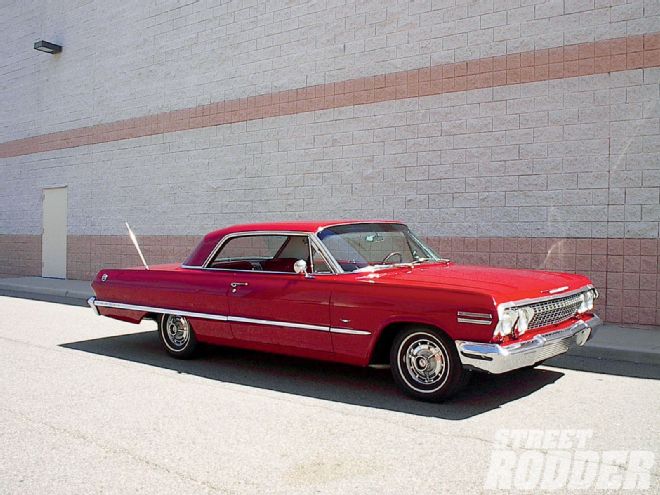
There are few among us who are more die-hard traditionalists than Dick Megugorac, aka Magoo. He bought his first car, a '27 T, in 1944 and has been driving hot rods ever since. Magoo has built everything-T tubs, '32s, chopped Mercs, and almost single handedly made highboy '29s on Deuce rails into an art form during the '70s and '80s. The guy knows what it takes to make a cool car and while he says he's loved every one that has come and gone, he simply describes his latest as "one of the most bitchin' of them all."
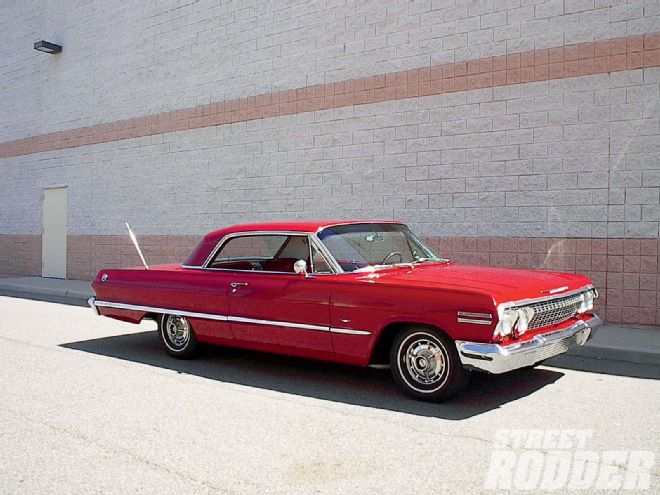 Dick "Magoo" Megugorac<br/>
found this pristine '63 Chevy and set about giving it the street rod treatment. Based on a nice amateur
restoration, like all Magoo's cars, this Impala will be gorgeous and a driver.
Dick "Magoo" Megugorac<br/>
found this pristine '63 Chevy and set about giving it the street rod treatment. Based on a nice amateur
restoration, like all Magoo's cars, this Impala will be gorgeous and a driver.
Magoo wanted a comfy cruiser, a desire fulfilled by this '63 Chevy Impala. A nice but not over-restored driver, all it needed was a little attitude with an altitude adjustment, and a disc brake upgrade. One of the other things on the to-do list was to add a better selection of gears than the original two-speed Powerglide provides. The obvious solution to that was the installation of a 700-R4 overdrive automatic, well known for its capacity to handle horsepower and excellent gear speed. When combined with the right rear end and tire diameter, this trans can supply stump pulling power with its 3.06:1 first gear and low rpm at cruising velocities with a 0.70:1 overdrive fourth cog.
For the trans Magoo turned to Phoenix Transmission Products. In business for 27 years, Phoenix goes to great lengths to supply transmissions built to suit the customer's specific application and modifications made reflect those requirements. If you're building a cruiser you don't want a transmission that shifts like it was built for drag racing, on the other hand if your car has lots of horsepower and you like banging gears more modifications are necessary. The point is, tell Greg Ducato, owner of Phoenix Transmission, all about your car and what you expect from it and he and his crew will do the rest.
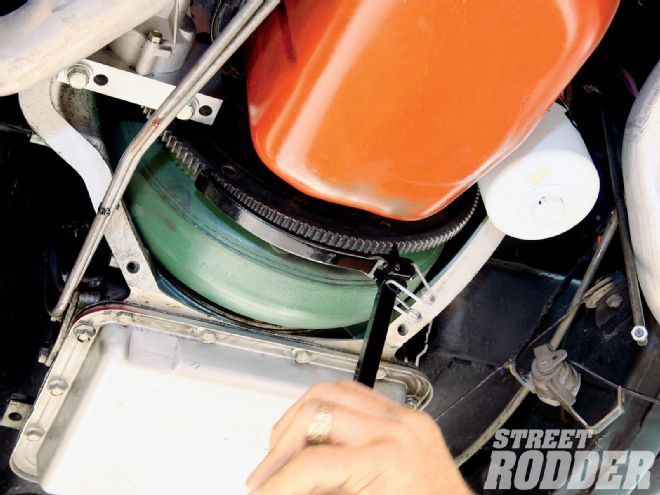 Once the bolts are removed, the torque converter will be free to move back toward the trans slightly-that movement must be present when installing the new transmission as well. If it isn't, the converter wasn't seated in the pump properly.
Once the bolts are removed, the torque converter will be free to move back toward the trans slightly-that movement must be present when installing the new transmission as well. If it isn't, the converter wasn't seated in the pump properly.
Although 700-R4s are in fact an excellent transmission, they have been known to shift erratically and fail prematurely. However, with a properly built transmission these problems can almost always be traced to improper throttle valve cable adjustment.
The Skinny on TV cable Adjustment from Greg Ducato
The throttle valve, or tv system, for transmission pressure control has been around since GM introduced the Hydramatic transmission before World War II. These early systems connected the accelerator linkage to the transmission and required skill and patience to adjust as well as some special tools. GM continued to use this type of system as did both Ford and Chrysler, until the '70s when a cable system was adopted. The more "modern" variants of this system have been in place since the '76 introduction of the TH-200 transmission. Mercifully, GM did away with the complex linkage and provided a simple cable system, which stayed in use until 1993 when throttle valve controls all together for fully computerized transmissions.
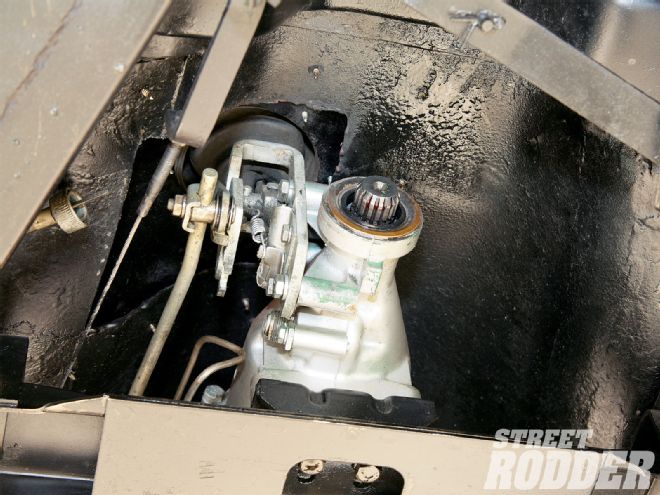 A minor complication with this swap is that the original floor shifter bolts to the tailshaft of the 'glide and the 700-R4 has no such provision. However, there are several solutions to that glitch.
A minor complication with this swap is that the original floor shifter bolts to the tailshaft of the 'glide and the 700-R4 has no such provision. However, there are several solutions to that glitch.
Understanding TV operation
Basically the tv system provides the transmission with pressure increase proportionate to throttle opening. This is done so the transmission will shift smoothly when cruising slowly or gently accelerating and keep the engine at a practical and efficient rpm. When accelerating quickly the engine is in a higher rpm range. Where it makes more power the transmission needs increased pressure to apply the bands and clutches and keep them from slipping.
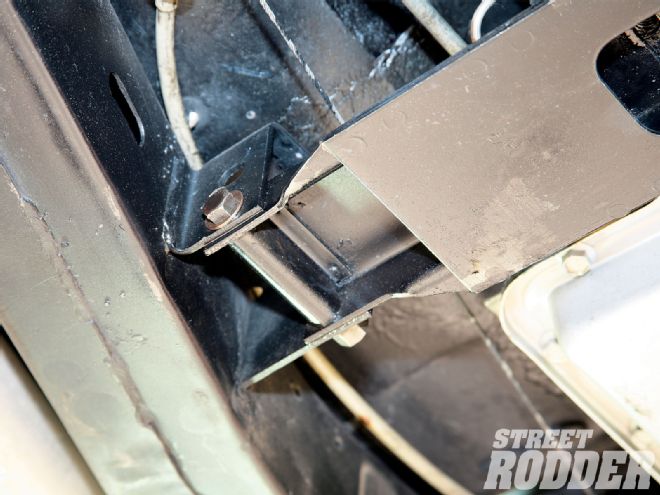 The stock crossmember attaches to the frame with a single bolt on each side.
The stock crossmember attaches to the frame with a single bolt on each side.
All GM transmission requiring a tv cable use the same basic range of adjustment. From idle to wide-open throttle, about 1-1/8 inches of cable are pulled, and at wide-open throttle the cable is as tight as it can be without limiting throttle travel. The cable is pulled in a straight line from idle to wide-open throttle to correctly keep transmission line pressure rise in harmony with throttle opening ensuring accurate shift points, shift firmness, and kick-down response. No matter what kind of cable system you are using, you should always verify that you have the correct range of throttle cable travel and that it is as tight as it can be at wide-open throttle. If you have these two parameters in place then you will have successfully adjusted your cable and your transmission will operate as designed.
Due to the very wide variety of carburetor and fuel injection systems it is impossible to design a cable that will work with every model and application. If you are using a Chevrolet-style Quadrajet these have the ideal ratio already designed into the linkage. In fact, nearly any Chevy carb used on a small-block application from the late '60s on up to the late '80s will have the correct linkage. In these instances, you can use the factory-style tv cable and bracketry to install and adjust your cable. These brackets may have been bolted to either the intake or the carb flange and routed the tv cable in a straight line with the attaching point at the carb linkage. If the factory-style linkage cannot be located, Holley sells a nice replacement bracket (PN 20-95) that not only holds a factory-style tv cable but also most GM throttle cables as well. For those with a Holley, Barry Grant, or AFB-style carb from Edelbrock or Carter, things get a little trickier since these do not have the proper geometry for proper tv cable operation and may pull out too much or not enough cable and at the wrong rate. At Phoenix Transmission they have developed individual brackets to correct tv problems with these carbs, allowing simple and precise adjustment without special tools or gauges. These levers simply bolt onto the carb linkage with supplied hardware and give perfect tv geometry. The can be used with stock-style tv cables or aftermarket cables such as those made by Lokar.
Making the Swap
Along with the gearbox, Phoenix Transmission supplied the crossmember kit and Hot Rods by Dean performed the exchange. And despite the fact this transmission swap is simple, one of the complications encountered was the Impala's console shifter. In stock form mounts to the Powerglides tailshaft, and even though the shifter could have been modified for the later transmission, it's still a two-speed design. For those wanting to retain the look of the original lever, the Shiftworks offers factory appearing replacements that will work with virtually any GM three- or four-speed automatic. In this case, originality wasn't a concern, so Magoo opted for the positive operation of a Lokar shifter.
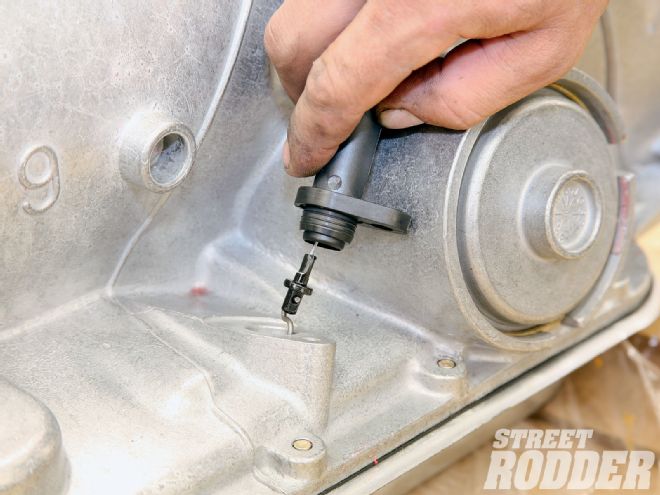 The throttle valve cable is critical to proper operation of the 700-R4. It hooks to a link connected to the valve body.
The throttle valve cable is critical to proper operation of the 700-R4. It hooks to a link connected to the valve body.
Phoenix Transmission FAQs:
Q: Do I need a computer or special wiring to install a 700-R4 in my non-computerized car?
A: No, the 700-R4 and 200-4R only need voltage to control the torque converter clutch solenoid, all the shifts are performed hydraulically. We wire our transmissions internally so all you need to do is attach a 12-volt source to the supplied pigtail and the trans will do the rest.
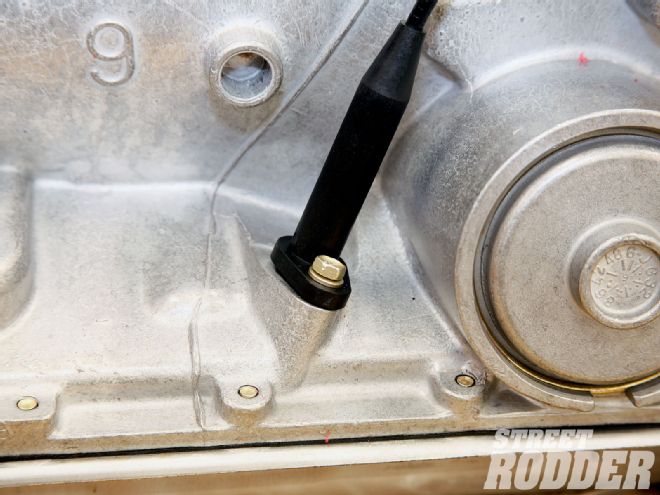 A single cap screw secures the tv cable housing to the case, an O-ring prevents oil leaks. Stock and aftermarket cables form Lokar are available from Phoenix.
A single cap screw secures the tv cable housing to the case, an O-ring prevents oil leaks. Stock and aftermarket cables form Lokar are available from Phoenix.
Q: Do I need a Lock-Up torque converter?
A: The greatest source of heat in an automatic transmission is the torque converter. This is because there is a constant source of friction within a converter and friction creates heat. Even the most efficient low-stall torque converter will never stop slipping so you will always have that source of heat generation in a non-locking converter.
When stall speed of a converter is increased the rpm that the converter must attain before it transmits full engine power back to the transmission is increased. While this is great for performance, it creates an even greater heat and efficiency problem. To make matters worse, in an overdrive transmission, even with steep gears, the engine rpm at cruise may be substantially less than the stall speed of the converter, a recipe for disaster. By applying a converter clutch, slippage and the heat it generates is eliminated while providing the benefits of a performance-oriented stall speed.
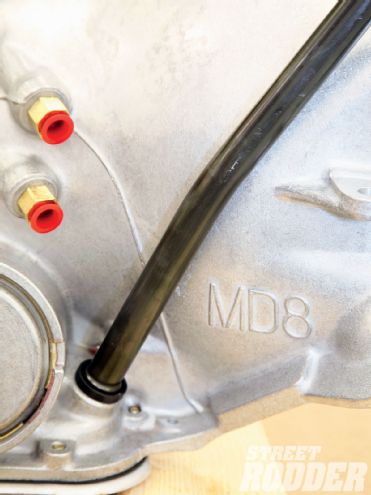 Stock and Lokar dipsticks and tubes are available from Phoenix. When hooking up the cooler lines on a 700-R4 the upper fitting is pressure, the lower is the return.
Stock and Lokar dipsticks and tubes are available from Phoenix. When hooking up the cooler lines on a 700-R4 the upper fitting is pressure, the lower is the return.
Q: What is meant by stall speed?
A: Think of a torque converter as two fans facing each other. The first fan is attached to the engine and as it spins it moves air to the second fan, which causes it to spin as well. This second fan is attached to the transmission. As the speed of the first fan increases it pushes greater amounts of air to the point where the second fan is turning at nearly the same speed. This would be considered stall speed. In the torque converter these "fans" are moving oil instead of air and by manipulating the angle of the fins, size of the converter and internal oil flow we can alter the speed at which the converter passes engine speed back to the transmission.
There are a couple of ways converter stall speed is rated, "brake stall" and "flash stall." Naturally a converter slips the most at idle by design, so when you are stopped at a light it doesn't drag the engine down like releasing a standard clutch. When the light changes and you ease on the throttle the converter begins passing engine torque to the vehicle gradually as rpm increases giving you a smooth ramp up to acceleration. This holds true for both stock and modified torque converters. If you were to hold the brake on and apply throttle until the engine stopped making rpm this would be "brake stall" speed. This is hard to measure because most performance vehicles will overpower the brakes and begin spinning the wheels before the stall point is reached. If you were to observe the tachometer as you made a full throttle launch with little or no wheel slip the tach would swing up quickly then stop and rise more slowly as the car accelerated down the track. The point to which the tach would quickly swing to would be the "flash stall" speed. You can also measure flash stall by having your transmission in top gear with the kick down linkage disconnected and floorboard the throttle, at approximately 45 mph this will indicate flash stall as well.
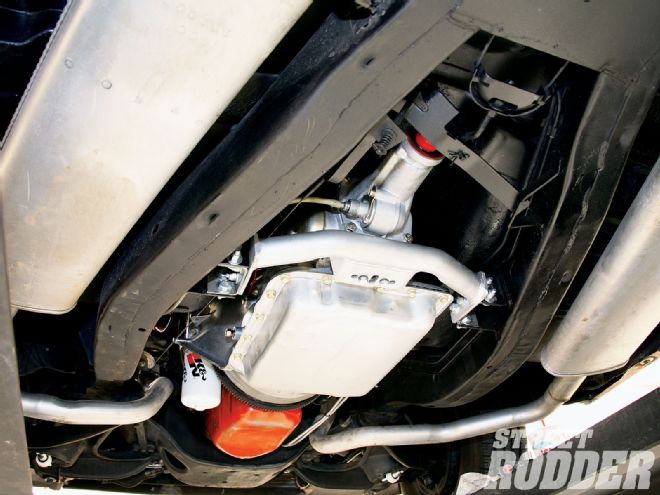 Clean and sanitary, everything about building a car should be this easy. Like other GM products, this Chevy has the goofy cruciform X-frame.
Clean and sanitary, everything about building a car should be this easy. Like other GM products, this Chevy has the goofy cruciform X-frame.
There are a great many variables used in rating a converter's stall speed, including cam size, engine torque, vehicle weight, and gearing, to name a few. An 1,800-pound T-bucket with a mild small-block can use the exact same converter to achieve 2,000-rpm stall speed as a 3,800-pound Chevelle with a warmed up big-block would use to obtain a 3,000-rpm stall speed. The difference is in the torque converter's ability to transfer engine power back to the trans. A heavier vehicle with more torque will need a higher rpm to achieve this transfer. That is why it is important that your converter builder have as much information as possible about your engine and vehicle combination so that he may design a converter to best get the power your engine makes transferred to the trans and rear wheels in the most efficient way possible.